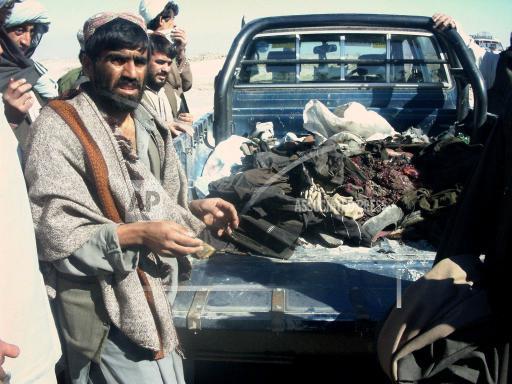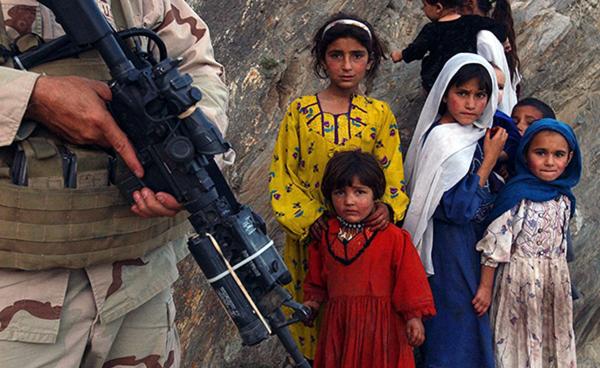U.S. President Biden has repeatedly labeled Russian President Putin a “war criminal.” Biden and other U.S. officials mouth deep outrage at the suffering of the Ukrainian people. They talk somberly about what is the best international venue to hold Nuremburg-style war crimes trials for Russian leaders. Ukrainian President Zelensky even told the UN Security Council that Russia’s actions in Ukraine constitute “the most heinous war crimes of all time since the end of World War II.”
Russia’s invasion of Ukraine is in fact a criminal violation of the sovereignty of another country, and it is fairly clear that its conduct of the war has involved serious war crimes, such as bombardment of civilian population centers like Kyiv, Mariupol, and Kharkiv. And there are reported cases of use of “cluster munitions”—bombs or shells that break up into smaller explosives that disperse over a wide area.
There are also allegations of rape, torture and murder, which at this point are largely undocumented and need to be investigated.
But as grievous as these crimes are, and even assuming that all the so-far-unproven allegations turn out to be true, they pale in comparison to the crimes of the U.S. imperialist war machine (including the CIA) that Biden represents and leads, and which Zelensky is closely allied with.
Below is a partial listing and brief description of some of the most egregious war crimes of the U.S. and its close allies in the period that Zelensky focuses on—“since the end of World War II.” These were crimes committed internationally, outside the U.S. borders (i.e., we have not included here crimes against humanity committed against Black people, Native people, and others within the U.S.).
Part 1 covered the period 1948-1979; Part 2 covered the period 1980-1992; Part 3 below covers the period up to the present.
1990 – Present:
MULTIPLE ACTS: Illegal Aggression Against and Occupation of Sovereign Countries; Overthrowing Governments, Executing Leaders and Installing Regimes That Serve U.S. Interests; Systematic Destruction of Civilian Infrastructure Causing Mass Suffering and Death; Illegal Detentions, Assassinations and Executions of Suspected Political Enemies; Systematic Torture
The “Middle East” Wars, Sanctions, and the So-Called “War on Terror”
For the last 32 years, the United States and its close allies have been continuously carrying out acts of war against people in the Middle East. This includes:
- The 1991 war against Iraq; estimated civilian deaths are between 70,0001 and 200,0002;
- Crippling sanctions—amounting to a medieval siege—imposed on Iraq from 1990 to 2003 causing widespread disease and malnutrition3; estimates of civilian deaths as high as 1.5 million, including more than 500,000 children under 5 years old as of 19994, 5;

Hospitalized Infant with diarrhea in Iraqi hospital, 1991. The combination of widespread malnutrition and lack of safe water due to crippling U.S. economic sanctions took a horrifying toll on hundreds of thousands of Iraqi children. Photo: revcom.us
- The 2003-2011 war on Iraq; estimates of civilian deaths, 186,0008-460,0009;
- The 2011 NATO bombing of Libya10, the deposing and lynching of its president, Muammar Qaddafi,11 and the triggering of a civil war that is still ongoing (with different imperialist powers backing different militias); estimates of civilian deaths in the civil war are reportedly between 10,000 and 25,00012;

Tripoli, Libya; residential building damaged during seven months of U.S./NATO bombing of Libya in 2011. Photo: AP
- The 2015-present; U.S.-backed, armed and financed war by Saudi Arabia and the United Arab Emirates (UAE) against Yemen; estimates of civilian deaths from violence and war-related hunger and disease, about 377,000.13
And beyond the deaths, this translates into decades of unspeakable horror and terror, misery and instability, wounds, disease, starvation and homelessness for large portions of the nearly 500 million people in the Middle East.14 It is, among other things, several generations of children growing up entirely in conditions of war.
Because of the tremendous scale and scope of these crimes, we can only touch on the most egregious, and then only briefly. And we also cannot get into the complex reasons why the U.S. has spent so many years and spilled the blood of so many people in this one region, and the interests of humanity in relation to all this. For a deep understanding of this, see Bob Avakian’s critically important work, Bringing Forward Another Way, revcom.us, March 2007.
But we can say this: Not one of the targeted countries committed an act of war against the U.S.; and not a single person was killed on American soil by the governments of any of these countries.15 These wars were completely unjustified and criminal in their very origins—wars of empire!
While the entirety of these acts of war are fundamentally criminal, we also want to draw attention to some specifics:
January 16-February 28, 1991
Bombardment of Civilian Populations, Bomb Shelters and Key Infrastructure; Genocidal Sanctions; Massacre of Demobilized Troops and Noncombatants
Iraq, Operation Desert Storm:
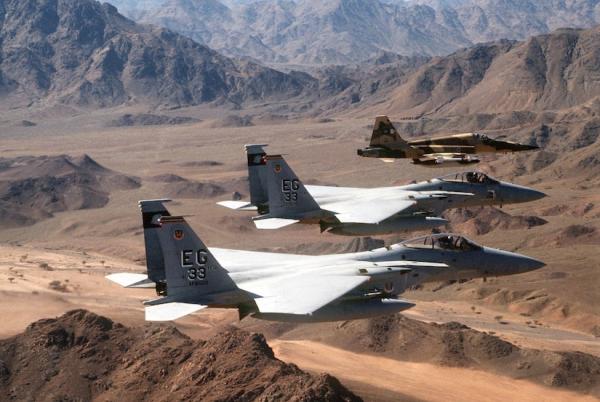
Operation Desert Storm: U.S. aerial and naval bombardment of Iraq and Kuwait began on January 17, 1991 and continued for six weeks. Photo: Wikipedia
This war was triggered by Saddam Hussein’s Iraqi regime invading and occupying the neighboring country of Kuwait. While the invasion of Kuwait was criminal, from the standpoint of the U.S. it was mainly another sign that Hussein—whom the U.S. had previously supported—was getting out of control and needed to be put in his place or gotten rid of.16 The U.S. mobilized a coalition of at least 57 countries to wage war on Iraq.
- For 43 days and nights, bombs and missiles pummeled Iraq—109,876 combat sorties dropped some 250,000 munitions—6,000 a day.17 In addition to what might be considered legitimate military targets, the bombing decimated civilian infrastructure, including oil and gas refineries, and electric generating stations. By the seventh day of bombing, Iraq’s entire electrical grid shut down. “Not an electron was flowing” according to a U.S. military official.18

For 43 days and nights, 109,876 combat sorties dropped some 250,000 munitions on Iraq, decimating civilian infrastructure, including oil and gas refineries, and electric generating stations. Photo: Revolution/revcom.us
- Without electricity, drinking water cannot be purified, nor pumped. So in Baghdad, Iraqis had to go to the Tigris River to collect water for their homes, but raw sewage was also being dumped in the river.19 In 1991, after the war ended, a Harvard public health team in Iraq found “‘epidemic’ levels of cholera and typhoid”—diseases spread through unsafe water. The team predicted that “170,000 children under five years of age will die in the coming year” as a result.20

March 1991, running water is rare in Baghdad following weeks of allied air raids. Here children collect water. Photo: AP/Dusan Vranic
Other Atrocities:
- The Amiriyah Shelter Massacre: On February 12, 1991, two laser-guided missiles slammed into a public fallout shelter in the Amiriyah neighborhood of Baghdad. At least 400 civilians were killed. The U.S. falsely insisted it was a “military command center” and has never taken responsibility for this mass murder.21

Hand prints of victims inside the shelter at Amiriyah, bombed by U.S. February 13, 1991. Photo: Wikipedia
- The Highway of Death: Once the ground war started, the bomb-battered Iraqi army quickly collapsed into mass surrender or chaotic retreat. It was clearly no longer an effective fighting force. As huge numbers, including many noncombatants, fled back towards Iraq, Chairman of the Joint Chiefs of Staff Colin Powell ordered U.S. forces to “cut them off and then kill them.” U.S. planes attacked both ends of the convoy of retreating vehicles, blocking off any escape, and for 48 hours coalition aircraft and ground forces attacked anything that moved. Thousands were slaughtered, and the six-lane “highway of death” was left littered with burnt-out vehicles and charred bodies. A U.S. soldier said it was like “a medieval hell.”22

On February 25, 1991, Iraqi forces were retreating north from Kuwait City to Basra in a long convoy of tanks, personnel carriers, trucks, buses, and cars. Planes of the U.S.-led coalition attacked both ends of the convoy, blocking off any escape, and for the next 48 hours coalition aircraft and ground forces attacked anything that moved along that strip of roadway. Thousands were slaughtered, and the six-lane “highway of death” was left littered with burnt-out vehicles and charred bodies. Photo: AP
Genocidal Sanctions:
- Sanctions remained in effect for 12 years after the war, preventing the import of parts and chemicals necessary to repair damaged water and power systems. Even four months after the war ended, Iraq had less than one-fourth of its pre-war electrical capacity.23 Three years after the war, only half of Iraqis had regular access to safe water.
- This led to a catastrophic public health crisis. Water-borne diseases like typhoid, cholera and diarrhea—which hit children especially hard—spread, causing widespread suffering and death.24 In 1995, an article in the respected medical journal The Lancet estimated that war and sanctions led to 567,000 deaths of children,25 and not long after UNICEF estimated 500,000. Yet sanctions were not lifted.
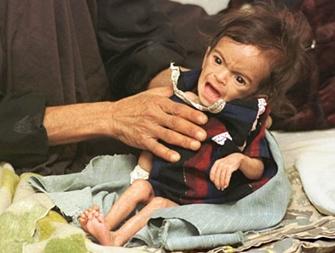
By 1998, 30 percent of Iraq’s children under five were malnourished because of the shortage of food and medicine, a result of the U.S./UN sanctions. Photo: al-Arabiya
- Sanctions also prevented or heavily restricted Iraq from selling oil, its main source of foreign currency with which to import food. Although a system of rationing prevented outright starvation, malnutrition was widespread, further weakening a disease-plagued population and amplifying suffering and death.26
- All this was intentional, guided by imperialist-gangster logic.
- A planner of the U.S. air campaign said: "People say, 'You didn't recognize that it was going to have an effect on water or sewage.' Well, what were we trying to do with sanctions—help out the Iraqi people? No. What we were doing with the attacks on infrastructure was to accelerate the effect of the sanctions."27
- A high-level Air Force official reasoned: "Saddam Hussein cannot restore his own electricity … If there are political objectives that the [U.S.-led] U.N. coalition has, it can say, 'Saddam, when you agree to do these things, we will allow people to come in and fix your electricity.' It gives us long-term leverage.”
- Another Air Force official said: “Big picture, we wanted to let [Iraqi] people know, ‘Get rid of this guy and we'll be more than happy to assist in rebuilding. We're not going to tolerate Saddam Hussein or his regime. Fix that, and we'll fix your electricity.’”28
- And, most damningly, U.S. ambassador to the UN (and future secretary of state) Madeleine Albright appeared on 60 Minutes in May, 1996 and had this exchange with host Lesley Stahl:
Stahl: We have heard that half a million Iraqi children have died. I mean, that’s more children than died in Hiroshima. And—and you know, is the price worth it?
Albright: I think this is a very hard choice, but the price—we think the price is worth it.29
“Madeleine Albright on 60 Minutes—“Half a million Iraqi children died?” It was “worth it.”
This is the outlook of a class of monstrous war criminals, who have a strange habit of accusing others of war crimes.
2001 – 2021
Invasion and Occupation of Sovereign Country; Deposing Government and Imposing Regime to Fit U.S. Interests; Bombings of Hospitals, Wedding Parties, and other Civilian Targets
The war in Afghanistan:
On September 11, 2001, members of the al-Qaeda organization led by Osama bin Laden carried out major attacks in the U.S., killing thousands. The U.S. rulers were stung—not by the loss of life, but by the loss of credibility as an “untouchable” gangster power. They could not allow something like this to happen without “making an example” out of someone. Because al-Qaeda operated out of Afghanistan (though it certainly did not act on “behalf” of or with the support of the vast majority of Afghan people), that “someone” became the Taliban-run government, and ultimately the people of Afghanistan.30
The U.S. quickly overthrew the Taliban, and installed a U.S.-compliant regime made up mainly of various warlords and others in the Afghanistan elite that had differences with the Taliban, or who switched sides when the U.S. came in. The Taliban were able to mobilize considerable support to oppose this regime, including many ordinary Afghans who disliked the Taliban but thought they were better than the foreign invaders and their corrupt puppet government.

- Afghanistan, a very poor, undeveloped and mostly rural country had already been through a decade-long war against the Soviet Union (which invaded in 1979) and six years of oppressive Taliban rule.31 The majority of people were living close to the edge even before the U.S. invasion. Now the U.S. war to maintain control would push many millions over the edge.
- Between 2004 and 2018, U.S.-led forces dropped 38,000 bombs on Afghanistan.32 By 2020 they had conducted at least 13,000 drone strikes, most of this in the countryside.33 The U.S. claimed that it put tremendous effort into avoiding civilian casualties, but in reality thousands of civilians died as a result of the U.S. invasion and occupation.34
- On August 22, 2008, a U.S. AC-130 gunship attacked a “suspected Taliban compound.” Villagers reported that it was no such thing; as many as 90 civilians were killed, the majority women and children.35
-
- In November, 2008, A U.S. air strike hit a wedding in Kandahar, killing or wounding as many as 90 people.36
- In October 2015, a MSF (Doctors Without Borders) hospital in Kunduz was decimated by an hour-long attack. U.S. gunships fired 211 shells at the hospital, killing 42 people. “Our patients burned in their beds, our medical staff were decapitated or lost limbs. Others were shot from the air while they fled the burning building.”

October 16, 2015: An employee of Doctors Without Borders walks inside the charred remains of the organization's hospital after it was hit by a U.S. airstrike in Kunduz, Afghanistan killing 42 Afghans. By August 2016, some 111,000 people had been killed and over 116,000 injured in the war. Photo: AP
-
- The U.S. first denied it was involved, then claimed the hospital was being used for military activities, then acknowledged it was a “mistake.”
- The director of the hospital said “The view from inside the hospital is that this attack was conducted with a purpose to kill and destroy. But we don’t know why.”37
-
- In September 2019, at least 40 civilians attending a wedding party in Helmand Province were killed by explosions and gunfire during a raid by U.S.-backed forces targeting a nearby “militant hideout.” Just days before, a U.S. drone strike killed 32 pine nut harvesters it "confused” with “militants.”38

U.S.-trained and backed Afghan security forces killed at least six civilians, including these two children, mourned here by villagers. At least 43,000 Afghan civilians were killed during the U.S. war in Afghanistan. Photo: AP
-
- On August 29, during the U.S. pull-out from Afghanistan, a man driving an SUV with a trunk full of water jugs was identified as a “terrorist” by U.S. drone surveillance. As he pulled up to his home, two missiles slammed into him. He and nine members of his extended family—including seven children—were killed in front of their parents, uncles and aunts.39
- Journalist Azmat Khan studied U.S. reports on airstrikes, then traveled to the sites to investigate. She found that the level of death and terror among civilians was systematically downplayed. Khan visited 15 households in Barang, a “hamlet of mud homes and farmland”—on average each household had lost five civilian family members to U.S. attacks. “A father killed in an airstrike while running for the forest. A nephew killed as he slept with his flock of sheep. An uncle shot by American soldiers as he went to the bazaar to buy okra for dinner.” She found none of these mentioned in Pentagon press releases.40, 41
- The effect of terror and violence in the countryside has been to wreck the rural economy, driving an estimated six million to flee, abandoning fields and herds either for the slums of Afghanistan’s cities or abroad.42 This, coupled with the economic crisis caused by the U.S. pullout (and overnight cutoff of most foreign aid) and recent drought deepened the food crisis. In 2020, revcom.us reported that “Chronic malnutrition has stunted the growth of a mind-boggling 41 percent of Afghan children under five. Half the population lives on less than a dollar a day.”43
2003-2011
Unprovoked Invasion, Overthrow of Foreign Government, Occupation, Execution of Foreign Leader, Massacre of Civilians, Torture
The Second War on Iraq
In March 2003, when it thought it had already “won” in Afghanistan, the U.S. launched a new war, targeting the Saddam Hussein regime in Iraq. Though supposedly part of the “War on Terror,” there was never any evidence that Hussein was involved in the 9/11 attacks—in fact he was known to be hostile to al-Qaeda. Stories drummed up to “justify” the coming mass slaughter—tales of secret stockpiles of chemical and biological weapons, and imminent development of nuclear weapons—all proved to be lies. Not “mistakes” or “bad intelligence,” but outright fabrications.44
Shock and Awe: This nickname for the initial U.S. attack immediately evokes the Nazi “Blitzkrieg” strategy, meant to overwhelm and terrorize an enemy into submission.
- In the first days of the war, “1,300 missiles and bombs were dropped on Iraq, most of them on Baghdad”45—the capital city with a population of nearly six million people. Over 7,000 ordinary Iraqis were killed in the opening six weeks of the war.46
- The U.S. quickly occupied the country and deposed the Hussein government. (Hussein was later arrested, put through an outrageous “show trial,” and executed.) But resistance to the U.S. was intense, and the U.S. response to that resistance was typically savage.
- Fallujah: A city of 300,000, Fallujah was a center of resistance. The U.S attempted to gain control in April of 2004 but failed. In November it launched an all-out offensive to crush the insurgents and to make an example out of the city. For eight weeks U.S. forces bombarded the city, and cut off water, power and food supplies. Two thirds of the population fled, often to squatters’ camps. Ten thousand U.S. troops then blasted their way in, backed by tanks, helicopters and bombers.

June 2004, Fallujah residents sift through rubble from U.S. airstrike—36,000 of the 50,000 houses in Fallujah, Iraq, were destroyed. Photo: AP
- The city’s main hospital was selected as a strategic target because “the American military believed that it was the source of rumours [about heavy civilian casualties at the hands of the U.S.]”47 So a key piece of civilian infrastructure was attacked because it was suspected of saying that the U.S. targets civilians!
- The American approach was captured by a colonel who said "The enemy has got a face. He's called Satan. He's in Falluja. And we're going to destroy him." A reporter said “Everyone in the street was a target for the Americans.” After two weeks the city was in ruins—36,000 of its 50,000 houses destroyed, along with 60 schools and 65 mosques and shrines. Reportedly, 4-6,000 Iraqis died, mainly civilians.48
- Abu Ghraib: In May of 2003, news and pictures revealed that U.S. soldiers and CIA agents were routinely torturing prisoners at Abu Ghraib, a U.S. Army detention center outside Baghdad with 3,200 inmates. Abu Ghraib had also been a torture chamber under Saddam Hussein. Now pictures showed Iraqi men, usually naked with suffocating hoods over their heads, being brutalized and humiliated by U.S. Military Police (MPs), who posed in these trophy pictures with wide grins, mocking the prisoners.
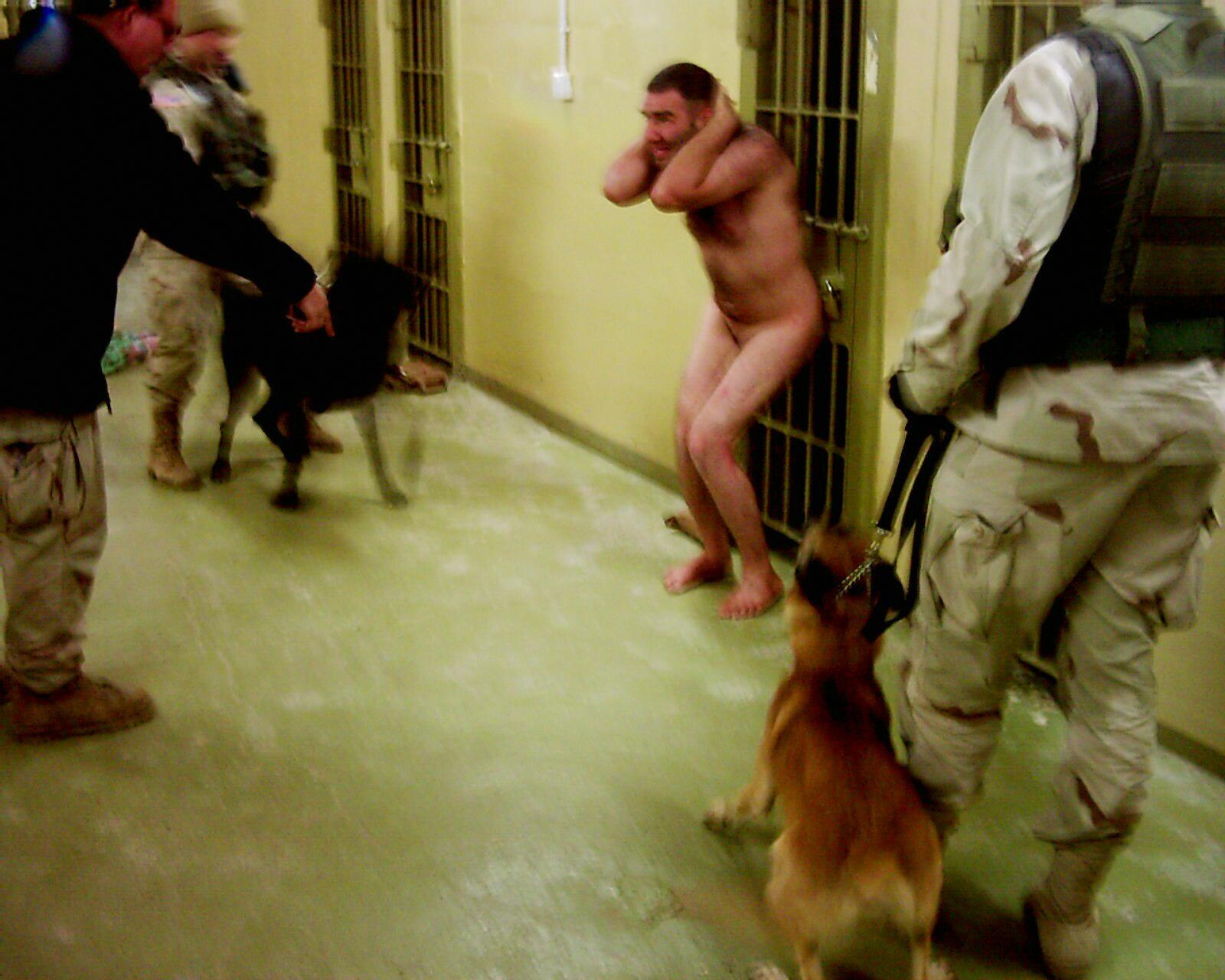
The U.S. Army and the CIA carried out systematic torture, including sexual assault and degradation, at the Abu Ghraib, Iraq, prison in Iraq. Photo: AP
- In one photo, a hooded Iraqi is shown balanced on small box, with wires attached to his fingers—he was forced to stand for hours, told that if he fell over from exhaustion, the wires would electrocute him. Another shows the corpse of a prisoner, beaten to death. Yet another shows a dog being unleashed on a helpless prisoner.
- A handful of low-ranking Americans were arrested, but it was clear from the fact that they took and circulated pictures that they had at least implicit approval from higher-ups. And lawyers for the arrested soldiers said that they were following orders, that they had been told to "soften up" the prisoners for the interrogations-to-come.49
- Collateral Damage: In 2010, Chelsea Manning, then a U.S. Army military analyst, leaked 250,000 documents to Wikileaks, many of which revealed serious war crimes by the U.S. One was a video of a 2007 helicopter attack in Baghdad. U.S. forces massacred 12 civilians and wounded two children, chatting, sometimes laughing as they fired. They opened fire on a group of seven or eight people—“all right—ha ha—I hit ’em… oh yeah look at those dead bastards”—then fired on people trying to put the victims in a van—“you should have a van in the middle of the road with 12-15 bodies… oh yeah, right through the windshield—ha ha.” After a U.S. tank rolled over one of the Iraqi victims, cutting him in half—“I think they just drove over a body… Really?... [laughing]… Yeah.”50
- Manning was arrested, jailed for months under brutal conditions, and sentenced to 35 years in prison for revealing the truth behind America’s claim to be “the good guys.” The U.S. is still pursuing prosecution of Wikileaks founder Julian Assange for this same “crime.”
2015-Present:
Bombing of Civilian Population Centers; Bombing of Hospitals, School Buses, Detention Centers, Telecommunications and Other Civilian Targets; Blocking Shipments of Food and Fuel to Famine-threatened Areas; Widespread Sexual Torture of Prisoners
The U.S.-Backed/Funded Saudi-UAE War Against Yemen:

Saudi Arabia and Yemen
In 2015, Saudi Arabia and the United Arab Emirates launched a land invasion and air war against Houthi rebels fighting against the Saudi-backed government. Through three administrations (Obama, Trump, Biden), the U.S. has sold tens of billions of dollars’ worth of advanced weaponry51 for this war. Green Berets, intelligence agents and surveillance planes provide support, and the Saudis drop U.S.-made bombs from U.S.-made planes that are refueled inflight by U.S. aircraft.52 And here are some of the consequences:
- On May 8, 2015, the Saudi military declared the entire city of Saada, 100,000 people, to be a “military target” and demanded that everyone “evacuate by 7 pm” that day.53
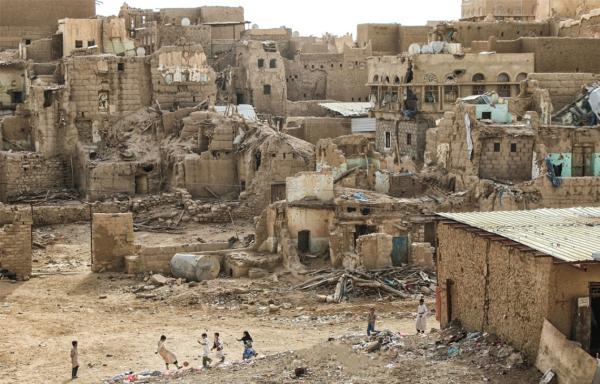
Massive destruction in Yemen—the U.S.-backed Saudi war has killed an estimated 377,000 Yemeni people. Photo: ICRC/Karrar al-Moayyad
- In six months in 2016, in the capital city of Sana’a, the Saudi’s bombed 19 medical facilities, including the city’s main hospital, and the Maternity and Children’s Hospital. They also all-but-completely shut down the electric grid in Sana'a for 18 months!54
- They have bombed at least three MSF (Doctors Without Borders) hospitals in Yemen, killing 19 people at one.
- In 2017 they blocked shipments of medicines for diarrhea, malaria, measles and malnutrition that were destined for the Save the Children Organization. In 2018, they blockaded the main port city of Hodeida, preventing food and fuel from getting in, as 22 million Yemeni people were facing hunger, and a cholera epidemic had hit one million. They also attacked Hodeida’s main hospital three times.55
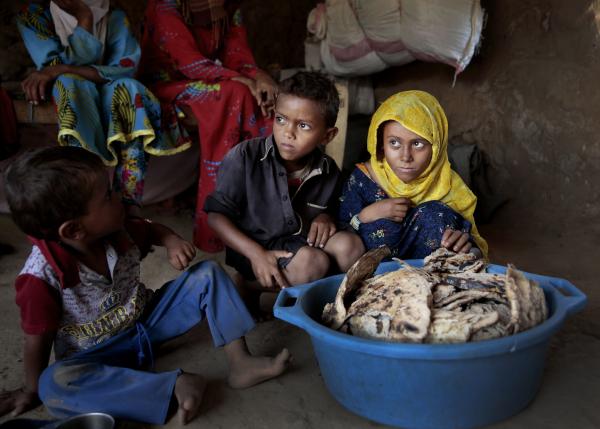
Thousands of Yemeni civilians are trapped in the embattled northern district of Hajjah. Here children sit around dish of moldy bread at a shelter. Photo: AP
- In 2018, they bombed a school bus full of children, killing 40.56

Saada, Yemen, August 9, 2018: U.S. bomb dropped by Saudi air force destroys school bus, killing at least 26 children. Photo: AP
- Also in 2018, it was revealed that UAE was running a network of secret torture prisons. Hundreds of prisoners were sodomized; some were videotaped during their torture. At least one of these prisons was located on a base where U.S. personnel are stationed. Prisoners insist it is impossible that the U.S. didn’t know about what was happening.57
Conclusion: At the beginning of this article we stated that the very real war crimes being carried out by Russia in Ukraine “pale in comparison” to the long history of U.S. war crimes. And now we will add that it’s not just the “totality” of U.S. war crimes that is overwhelming—if you look at almost any specific instance covered in this article—at the coups and civil wars in Guatemala; at the genocidal war in Vietnam; at the murderous sanctions against Iraq; at the war in Yemen—Russia’s crimes in Ukraine “pale in comparison” to any single one of them, much less all of them.
Our point here however is not fundamentally to compare imperialists and try and figure out “who’s worse” (much less “who’s better”!) They are both “worse”—both are imperialist powers that are driven by the dynamics of capitalism to expand or die, driven by the need to expand to seek empire, and driven by the need to seek empire to commit horror after horror after horror against the people and the planet.
The point is that it is time, past time, long past time for humanity to put all of this behind us, for more and more people to take up the science of revolution, become part of the struggle for revolution, and follow the leadership of the revolution so that we can start spreading emancipation and liberation around the world, instead of atrocity.

